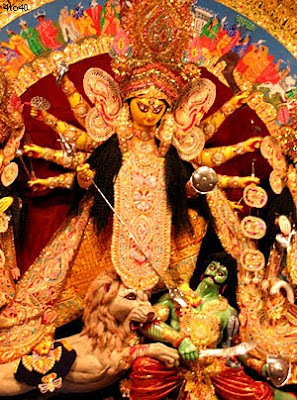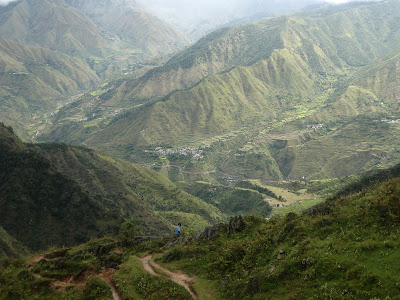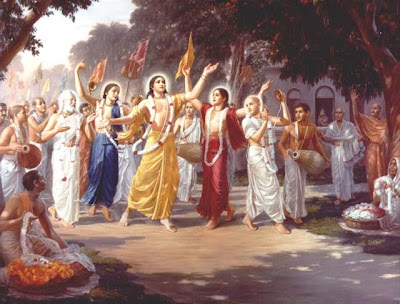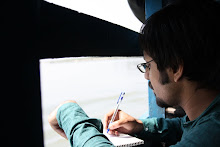
Durga Pujo is around the corner. When I was a kid, the very thought used to make me go weak in the knees with happiness. Tired as I grew of it, Cal's pujo is still something to behold. In my opinion, it is the closest one comes to a carnival in this country, apart from the actual Goa carnival of course. Great memories, happy memories.
Right now, all I can think of is one thing- going to the mountains. If anything can be said to have usurped Durga Pujo's place in my affections, it has got to be the mountains. In fact, the joy I get from altitude far outstrips my childhood fondness of Pujo.
Why? Well lots of reasons really. But if I were to really put my finger on it, it would be this- the Himalayas- and other hills and mountains- are the only places which are truly spiritual to me. I mean, to walk for hours up or down mountains, through the humming quiet of the roads and forests and rocks and fields; to see geography crumpled up and refashioned on such a gigantic scale; to see the high peaks glistening unimpeachably in the sky, and to look down to see deep blue valleys emerging as if out of some primordial dream of belonging- that is the closest I come to any sort of religious epiphany. I mean, if the beauty of the land can bring tears to your eyes, isn't that something to cherish? Outside of the Bengal-Bihar countryside, where I grew up- no other place affets me as deeply.
Hence, not a month goes by without me feeling eternally grateful for my life- to be able to live and work in a place from where the mountains are just six hours away; and the high Himalayas a mere 14 hours.
My parents travelled ceaselessly, or so it seemed to me as a child. From our home in Purnea in North East Bihar, Siliguri via Kishanganj was only a six to eight hour drive away, so I'd been going to Darjeeling from the age of two. Puri was the other favourite, us being Bongs, so many a holiday was spent there as well.
But some of my favourite trips with my parents has been to the mountains. I remember the December jaunt to Manali- my first snowfall!!- in 1996 and the absolutely superlative Kedarnath-Badrinath trip of 1999. That's when I really started to see the mountains as something beyond the promise of cool climes and snow peaks. The sheer sensory experience of the Garhwal was something. I'll never forget the Kedarnath massif rising out of a cloudy dawn behind the temple of Kedarnath, or Nilkantha floating like a shark's tooth in the air above Badrinath. But it wasn't just the peaks. What I loved best was the journey to get there.
Kedarnath from Gaurikund was the first trek of my life and quite unforgettable. You start among the thick forsts of Gaurikund, and over the next 14 km, you rise up inexorably to finally emerge into the high valley above the treeline, springy turf under you and exhilirating vastness all around you.
While in college, me and some friends made our way to the Valley of Flowers in 2001. A magical land if I've ever seen one, this was high altitude all right, and I realised that the Himalayas are a most happy addiction.
Imagine my plight then, when for five long years various circumstances kept me apart from my love. Only in 2006 could I go again, this time to Mussoorie. I was aghast to find the same spoilt Delhi brats whining in a Cafe Coffee Day store on the Mall Road, but heck I could not argue with the bits of clouds playing hide and seek with me around the lush mountains of Tehri Garhwal.
Another long wait of two years. By 2008 I'd had enough of all this dicking about in the city, trying to earn a livelihood and all that. So I took off to McLeodganj to meet my friend KP who was staying there. Took another friend of mine, Debo, along.

Pic: Dharamshala and Kangra Valley shrouded in clouds, seen from McLeodganj
This was it, mountain madness had finally caught up with me and had claimed me for its own. In fact I can pinpoint the moment when it happened. The first was when I awoke at dawn on the bus to Dharamshala to find us in the middle of the Shivalik highlands of Himachal Pradesh, going past a beautiful river, on the way to Kangra. In the distance, through the clouds I could see the giant ramparts of the Dhauladhars sweeping up to the sky. At that moment, I knew exactly what I'd been missing all this time.

Pic: Triund, on the ramparts of the Dhauladhar Range.
The second moment came a few days later. Debo had returned to Delhi, and me and KP were making our way up to Triund on the shoulders of the Dhauladhars, on the way to Indrahar Pass.
Trekking up after so many years with a spoilt body full of smoke and repose was always going to be hard. The fact that I was shit stoned didn't help much either. In fact, considering the difficulty, I insisted on getting even more high, and KP was only too willing. Half way up Triund, at around 2 pm or so, wheezing and pulling my tired, screaming legs up the next boulder with my heart threatening to jump right out of my body, the clouds which had surrounded us for much of the trip burst and rain came pouring down. My predicament just got worse. Not only did this meant that the going got even tougher, as veritable rivers of mud were flowing down the quagmire of a track but my dope paranoia made me imagine that the mountain was for some reason trying to shrug me off its back. Still, we kept trudging, past immense boulders and even larger dead tree trunks in a shadow land of cloud, thunder and rain. Finally, after what seemed like an eternity, we came around a bend and-Triund! A high altitude meadow, with a gentle mist hanging over it and myriad little flowers blooming in the grass. That's when I was convinced that this was the life for me.
Fortunately, that trip pretty much opened the floodgates. Next I went to this place called Viratkhaai above Chakrata in Western Garhwal for an adventure sport camp. I lost a tooth falling off a bike and got ravaged by leeches, but the place was magical.

Pic: The Yamuna coming down from the mountains north west of Mussoorie.
The monsoon had just hit and the various valleys were wrapped up in a shroud of mystery, as our Press bus went up along crumbly roads over horrid precipices up to the camp, past beautiful waterfalls and entire river systems swollen into floodwaters thanks to the incessant rain.

Pic: Mountains of Tehri Garhwal at Dhanolti near Mussoorie.
Next I went to Mussoorie again, which was pleasant. Come October, and I was off to Bhuira, this charming hamlet in the Shimla hills of eastern Himachal.

Pic: A cairn atop a hill in the Shimla hills near Bhuira
While there, us friends trekked up this local hill top. Crisp in the fall sunshine, I tugged at my beard and spaced staring off into the middle distance.
Early this year, in March, while it was still cold enough to discourage tourists, me and a friend of mine, Priyo went off to Binsar, a forest sanctuary above Almora in the Kumaon hills. Having missed a bus, and then having travelled for a full 12 hours through North UP (hell on wheels), when we woke up to a stunning Himalayan panorama (pic below) it was all worth it.

Pic: Nanda Devi and other giants at dawn, seen from Binsar.
Each and every moment of my time there was sublime- whether it was staying in a century-old forest guest house in the middle of an oak and rhododendron forest with some immense cedars for company, or the sight of the majestic Kumaoni peaks- Trishul, Nanda Devi, Nanda Ghunti, Panchachuli among them- or a fabulous trek of some 20 km through the beutiful valleys and ridge-tops of the Almora hills to the ancient temple town of Jageshwar from there.
Another trip to McLeodganj followed in April. This time there were quite a few of us, and the pace was less frantic. Indeed, for once, I was happy not to try and cover too much ground and just relax instead (I still forced them up to Triund though!).
Then in May, on my birthday along came the big trip to Tunganath and Chandrashila, again in the Kedarnath mountains of Garhwal.

Pic: The high Himalayas of north Garhwal, Tunganath.
I'd never been this close to the Greater Himalayas before, and although because of unseasonal bad weather I couldn't do the extensive trekking that I'd planned, climbing up to the top of Chandrashila at over 4000m was heady enough.
Over the next month, making my way through work and bad news I felt so horrible in Delhi, that I made another quick jaunt to McLeodganj. I have friends there now- especially a group of young locals who run home stays for European and American backpackers in the villages of upper Bhagsu and Dharamkot, above McLeodganj.
That was in June. Haven't been back to the mountains since. All I've been able to do to keep my mountain-starved mind from going insane is to read countless fabulous books on the mountains, my favourite ones among these being my hero
Eric Shipton's collected travelogues and Journals, and the travel writings of my other mountain hero Umaprasad Mukherjee- some of whose peerless Bengali essays,
I've tried to translate.
So, why all this talk about mountains at the end of September? Well, it ties in with what I said at the beginning of the blog. Durga Pujo is around the corner again, and this time, I hope to be back in Tunganath, staying in Sujaan Singh's lovely choti- with probably one of the best alpine views in the world- and meeting the irrepresible Biru.

Pic: The view outside Sujaan Singh's unassuming choti at Tunganath.
I intend to hijack him and make him take me to Madhmaheshwar and Deoria Tal, two absolutely fantastic places in the deep valleys and high ridges of the Kedarnath mountains along one of the greatest watershed areas on earth.
I've got my fingers crossed.





